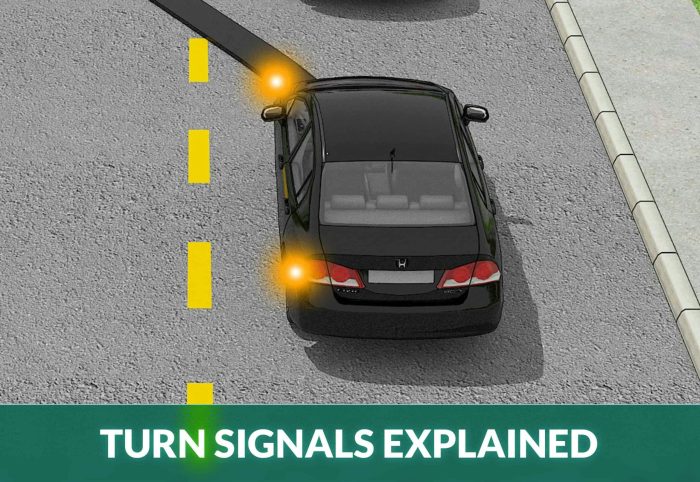Sie wollen nach rechts abbiegen wie sollten sie sich verhalten – Navigating a right turn may seem like a simple maneuver, but it demands meticulous attention to proper driving etiquette, vehicle positioning, and situational awareness. This comprehensive guide, “How to Execute a Right Turn: A Comprehensive Guide for Drivers,” delves into the intricacies of making a right turn, ensuring safety and efficiency on the road.
To execute a safe and effective right turn, drivers must possess a thorough understanding of hand signals, blind spot checks, and anticipation techniques. Additionally, they must be familiar with the concept of right-of-way, vehicle positioning, and post-turn actions.
Driver Behavior

To execute a safe and legal right turn, drivers must adhere to specific behavioral guidelines. These guidelines ensure proper communication with other road users and minimize the risk of accidents.
Hand Signals
- Extend the right arm out of the window, bent at the elbow, with the forearm pointing straight up.
- Flick the forearm down once or twice to indicate the intention to turn right.
Blind Spot Checks
- Before turning right, drivers should glance over their right shoulder to check for vehicles in their blind spot.
- If a vehicle is present, the driver should wait until it has passed before proceeding with the turn.
Anticipating Vehicle Actions
- Drivers should be aware of the actions of other vehicles, especially those approaching from behind.
- If another vehicle is approaching quickly, the driver should yield and allow it to pass before turning.
Vehicle Positioning: Sie Wollen Nach Rechts Abbiegen Wie Sollten Sie Sich Verhalten

Proper vehicle positioning is crucial for executing a safe and efficient right turn. It ensures optimal visibility and minimizes the risk of collisions.
Lane Position
When preparing to turn right, drivers should position their vehicle in the right-hand lane closest to the curb.
Distance from Curb
It is important to maintain a safe distance from the curb when turning right. This prevents the vehicle from hitting the curb or pedestrians.
Adjustments
Drivers may need to adjust their vehicle’s position based on road conditions and traffic volume. For example, they may need to move closer to the curb in narrow lanes or further away in heavy traffic.
Right-of-Way Considerations

Understanding right-of-way rules is essential for avoiding accidents when turning right. Drivers must yield to vehicles and pedestrians with the right-of-way.
Vehicles with Right-of-Way, Sie wollen nach rechts abbiegen wie sollten sie sich verhalten
- Vehicles approaching from the opposite direction
- Vehicles traveling straight in the same direction
- Pedestrians crossing the street
Yielding
Drivers must yield to vehicles and pedestrians with the right-of-way. This means slowing down or stopping to allow them to pass.
Situations to Wait
- When oncoming traffic is approaching
- When pedestrians are crossing the street
- When there is insufficient space to turn safely
Turn Execution

Executing a right turn smoothly and safely requires proper speed control and vehicle handling. Drivers should maintain a steady speed and avoid sudden acceleration or deceleration.
Speed
The ideal speed for executing a right turn is slightly slower than the posted speed limit. This allows drivers to safely navigate the turn without losing control.
Acceleration
Once the turn is initiated, drivers should smoothly accelerate out of it. Rapid acceleration can cause the vehicle to skid or lose traction.
Control
Drivers must maintain control of their vehicle throughout the turn. This involves keeping both hands on the steering wheel and making gradual, smooth adjustments.
Post-Turn Actions
After completing a right turn, drivers must take appropriate actions to ensure safety and maintain traffic flow.
Signaling
Drivers should signal their intention to return to the original lane after completing the right turn.
Lane Positioning
Drivers should return to the proper lane position, typically the right-hand lane closest to the curb.
Speed and Awareness
Drivers should adjust their speed and maintain situational awareness after turning right. This ensures they can safely merge into traffic and respond to any unexpected events.
Q&A
What is the proper hand signal for indicating a right turn?
Extend your right arm out of the window, bending it at the elbow, and point your fingers down.
How can I check my blind spots before turning right?
Use your mirrors and glance over your right shoulder to ensure there are no vehicles or pedestrians in your blind spots.
What should I do if another vehicle is approaching from the opposite direction when I want to turn right?
Yield to the oncoming vehicle and wait for it to pass before proceeding with your turn.